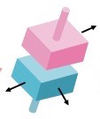Basic Anatomy Flashcards
Which of the anatomical planes splits the body down it’s center line (through nose and belly button)?
The Sagittal plane
Which anatomical plane cuts across the body like a magician sawing someone in half?
The Transverse plane
Which anatomical plane splits the body down its side?
The frontal or Coronal plane
Medial refers to a position that is closer to what?
The center of the body: “The heart is medial to the ribs”
The shoulder joint is _____ to the sternum.
Lateral (further from the center)
Anterior refers to the ______ of the body.
Front
What is the opposite of anterior?
Posterior or Dorsal
What is a synonym for anterior?
Ventral
Appendicular refers to what?
The limbs
Axillary refers to what?
The trunk of the body
When referring to the appendicular skeleton, the fingers are ______ to the shoulder.
Distal (further from the point of attachment)
The femur is ________ to the knee cap.
Proximal (closer to the point of attachment)
The head is ________ to the heart.
Superior
The heart is ______ to the neck.
Inferior
Cranial refers to something towards the _____.
Head
Caudal refers to something towards the _____.
Feet
Something that is superficial is ______.
Closer to the skin or shallow.
The opposite of superficial is ______.
Deep
When it comes to joints, there is an inverse relationship between ____ and ____.
Stability and mobility
The 4 types of joint movement are:
- Nonaxial (gliding, see carpals) 2. Uniaxial (hinge or pivot, see elbow) 3. Biaxial (Condyloid or saddle joint, see thumb) 4. Triaxial (Ball and socket, see shoulder and hip)
What type of joint is this?

Pivot joint
Example: Vertebrae
What type of joint is this?

Saddle joint
Example: Medial end of the clavical.
What type of joint is this?

Ball and Socklet
Example: The hip
What type of joint is this?

Condyloid
Example: The knuckle joints where fingers meet hand.




